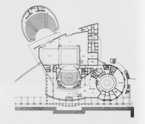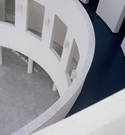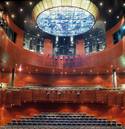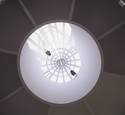The Slovene National Theatre Nova Gorica
alias Primorje Drama Theatre (1969 - 2003), Gorica Town Theatre (1955 - 1969)Trg Edvarda Kardelja 5, SI-5000 Nova Gorica | |
| show on the map | http://www.sng-ng.si/ |
Important events
The plans were created by architect Vojteh Ravnikar and his colleagues Majda Planišček, Slavko Škulj, Irena Lozič, Metka Žerovnik, Petra Maležič, Meta Hočevar, and Maruša Zorec.
The opening performance was Krst pri Savici written by Dominik Smole and directed by Janez Pipan.
People
History
Ten years after the completion of the building of the theatre, i.e. in 2003, the Primorsko dramsko gledališče Nova Gorica (The Primorje Drama Theatre) gained the status of national importance and changed its name to Slovensko narodno gledališče Nova Gorica (Nova Gorica Slovene National Theatre). A year later Slovenia joined the EU and the central European festivity, attended by the President of the Commission Romano Prodi and the Slovene Prime Minister Anton Rop, took place on the Slovene-Italian border, only a few hundred metres away from the theatre. The wall that divided the town, though for some time more psychological than real, is no more. The curtain has fallen. The symbols of two former conflicting worlds – the West and the East – that are now two cooperating towns – Gorizia and Nova Gorica – are inextricably linked with the significance of the new theatre building.
The theatre building and the accompanying facilities are the only architectural site of this kind and the last one built by Vojteh Ravnikar and his colleagues in the post-modernist style. The architect began drawing up the plans in the post-Tito period – in 1987 – when the post-modern movement in architecture and theatre was at its peak in Slovenia. The building was completed in 1994, when faith in looking into the past had waned slightly and society was already looking for a new path in the independent state.
The building closes the eastern side of the central Nova Gorica square and gives it a new focus with its theatrical content. This is shown externally in the shape of two basic spatial bodies and in the form of the relationship between the large central square section with the auditorium and the corner cylinder where the theatre's administrative offices are to be found. The two sections are encased in de-materialised structures, which give scale and intimacy to the whole, and mark the transition from the exterior to the interior. The main entrance is slightly raised and lies on the axis of the square. It is emphasised with a portal and pillars on two levels so that the brick columns on the upper section of the building become slender concrete pillars. Via a two-level foyer with a staircase we enter the auditorium, which has a festive appearance. The circular auditorium reminds the viewer of archetypal theatres such as the Globe Theatre in London. Together with its colourful ceiling stained glass, the work of the artist Vladimir Makuc, it gives the members of the audience the impression that they are outside in the material world throughout, in spite of their thoughts following the course of the theatre performance inside. The administrative offices are in the neighbouring cylindrical building with its circular multi-storey foyer. They are entered via a circular corridor that is opened towards the central hall. At the top in the middle of the cylinder is a small glass cone. It seems that the cogs in the administrative building are constantly turning and grinding, thus propelling via levers the neighbouring auditorium and the stage.
The theatre building, with its covered columns and the emphasised portal, flirts with the municipal building designed by Vinko Glanz during the period of the socialist renovation. The building also has something in common with the modernist tradition of the town that appeared after 1947. When designing the Nova Gorica theatre the architect played with a whole range of compositional and architectural elements and materials: brick, plaster, marble and concrete.
The development of theatrical activities in the Gorica area was diverse. Gorica theatre began appearing in 1905 in the Slovene Trade Centre in Gorica, but with the emergence of Fascism Slovene theatrical activities were banned. After the end of World War 2 the new socialist authorities, as a response to the loss of Gorizia which was annexed to Italy, built a new regional centre where in 1955 the Gorica Town Theatre was founded. Until 1969 it was semi-professional and then became professional and changed its name to the Primorje Drama Theatre. It is worth drawing attention to the Mediterranean note in the selection of performances, as well as the openness of the ensemble, where alongside the permanent acting team outside actors appear as guests, in addition to a quality selection of directors such as Mile Korun, Dušan Jovanović, Dušan Mlakar, Eduard Miler, Vito Taufer, Mateja Koležnik, Jaša Jamnik, Jernej Lorenci, Matjaž Latin, Diego de Brea, Ivana Djilas, Georgij Paro, Paolo Magelli, Janusz Kica, Dejan Mijač and Slobodan Unkovski, all of which enables modern approaches and explorations. The high quality of the ensemble, numerous awards at festivals at home and abroad and guest appearances by foreign theatres in Nova Gorica during the second half of the 1980s required better working conditions and the new building now presents a challenge for continued creative and unifying activities within the European context.
Literature and sources:
Vojteh Ravnikar / Arhitektura / Architecture, Ljubljana: Fundacija Piranesi 2003, pp. 40-45
Tomaž Brate, Zid, Travnik, Ljubljana: Piranesi 4, III, 1994, pp. 62-75
Author: Bogo Zupančič
Bogo Zupančič:
The Slovene National Theatre Nova Gorica, Trieste Permanent Slovene Theatre, The Old Power StationTranslator: Maja Visenjak Limon
Maja Visenjak Limon:
The Miners’ Theatre in Idrija, The Tartini Theatre, Ptuj Town Theatre, Slovene People's Theatre Celje, The Slovene National Theatre Drama, Ljubljana, The Koper Theatre, The Slovene National Theatre Maribor, The Slovene National Theatre Opera and Ballet Ljubljana, The Prešeren Theatre, Kranj, Maribor Puppet Theatre, The Slovene National Theatre Nova Gorica, Ljubljana Puppet Theatre and Šentjakob Theatre, The Estates Theatre in Ljubljana, Trieste Permanent Slovene Theatre, The Old Power Station, The Mladinsko TheatreAdditional information
No information has yet been entered
Add information

















